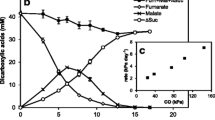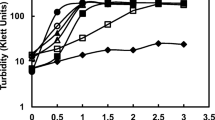Abstract
Seven strains of extremely halophilic bacteria (Halobacterium spp., Halococcus spp., and Haloarcula sp.) fixed CO2 under light and dark conditions. Light enhanced CO2 fixation in Halobacterium halobium but inhibited it in Halobacterium volcanii and Haloarcula strain GN-1. Propionate stimulated 14CO2 incorporation in some strains, but inhibited it in others. Semi-starvation in basal salts plus glycerol induced enhanced CO2 fixation rates. 14CO2 fixation in semi-starved cells was stimulated by NH +4 or pyruvate and inhibited by succinate and acetate in most strains. No possible reductant was found. In cell-free extracts of H. halobium, NH +4 but not propionate stimulated 14CO2 fixation. No RuBP carboxylase activity was detected. The main 14C-labeled α-keto acid detected after a 2-min incubation with 14CO2 and pyruvate was pyruvate. Little or no α-ketobutyrate was detected among the early products of propionate-stimulated CO2 fixation. Glycine was the major amino acid synthesized during a 2-min incubation with NH +4 , propionate, and 14CO2. Propionate-stimulated CO2 fixation was sensitive to trimethoprim and insensitive to avidin. A novel pathway for non-reductive CO2 fixation involving a glycine synthase reaction with CO2, NH +4 , and a methyl carbon derived from the β-carbon cleavage of propionate is tentatively proposed.
Similar content being viewed by others
Abbreviations
- BBS:
-
buffered basal salts
- HEPES:
-
N-2-hydroxyethylpiperazine-N′-2-ethanesulfonic acid
- MOPS:
-
3-(N-morpholino)propanesulfonic acid
- DNPH:
-
2,4-dinitrophenylhydrazine
- DNP:
-
dinitrophenyl
- TLC:
-
thin-layer chromatography
- FH4 :
-
tetrahydrofolate
References
Barker HA, Volcani BE, Cardon BP (1948) Tracer experiments on the mechanism of glycine fermentation by Diplococcus glycinophilus. J Biol Chem 173:803–804
Buchanan BB (1969) Role of ferredoxin in the synthesis of α-ketobutyrate from propionyl coenzyme A and carbon dioxide by enzymes from photosynthetic and nonphotosynthetic bacteria. J Biol Chem 244:4218–4223
Bush RS, Sauer FD (1977) Evidence for separate enzymes of pyruvate decarboxylation and pyruvate synthesis in soluble extracts of Clostridium pasteurianum. J Biol Chem 252:2657–2661
Daniels L, Zeikus JG (1978) One-carbon metabolism in methanogenic bacteria: Analysis of short-term fixation products of 14CO2 and 14CH3OH incorporated into whole cells. J Bacteriol 136:75–84
Danon A, Caplan SR (1977) CO2 fixation by Halobacterium halobium. FEBS Lett 74:255–258
Forti G, Meyer EM (1969) Effect of pyrophosphate on photosynthetic electron transport reactions. Plant Physiol 44:1511–1514
Fuchs G, Stupperich E (1986) Carbon assimilation pathways in archaebacteria. Syst Appl Microbiol 7:364–369
Gready JE (1980) Dihydrofolate reductase: binding of substrates and inhibitors and catalytic mechanism. Adv Pharm Chem 17:37–102
Javor BJ (1984) Growth potential of halophilic bacteria isolated from solar salt environments: carbon sources and salt requirements. Appl Environ Microbiol 48:352–360
Javor B, Requadt C, Stoeckenius W (1982) Box-shaped halophilic bacteria. J Bacteriol 151:1532–1542
Kandler O, Stetter KO (1981) Evidence for autotrophic CO2 assimilation in Sulfolobus brierleyi via a reductive carboxylic acid pathway. Zbl Bakt Hyg, I Abt Orig C 2: 111–121
Oren A (1983) Bacteriorhodopsin-mediated CO2 photoassimilation in the Dead Sea. Limnol Oceanogr 28:33–41
Robinson JR, Klein SM, Sagers RD (1973) Glycine metabolism. Lipoic acid as the prosthetic group in the electron transfer for protein P2 from Peptococcus glycinophilus. J Biol Chem 248:5319–5325
Rosenshine I, Zusman T, Werczberger R, Mevarech M (1987) Amplification of specific DNA sequences correlates with resistance of the archaebacterium Halobacterium volcanii to the dihydrofolate reductase inhibitors trimethoprim and methotrexate. Mol Gen Genet (in press)
White A, Handler P, Smith EL, Hill RL, Lehman IR (1978) Principles of biochemistry, 6th edn. McGraw-Hill Kogakusha, Tokyo
Zweig G, Sherma J (eds) (1972) Handbook of chromatography, vol 2. Chemical Rubber Co, Cleveland
Author information
Authors and Affiliations
Additional information
This work was supported by National Science Foundation grant PCM-8116330 and Petroleum Research Fund grant PRF 13704-AC2
Rights and permissions
About this article
Cite this article
Javor, B.J. CO2 fixation in halobacteria. Arch. Microbiol. 149, 433–440 (1988). https://doi.org/10.1007/BF00425584
Received:
Accepted:
Issue Date:
DOI: https://doi.org/10.1007/BF00425584




